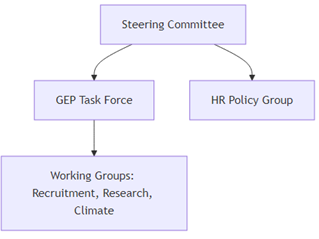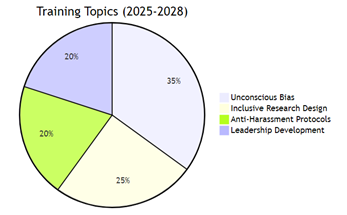Gender Equality Plan (GEP) 2025-2028
ISAAAC Global New Generation Think Tank - Salamanca
I. Executive Summary
This 4-year plan outlines ISAAAC’s commitment to gender equality through structural reforms, inclusive policies, and cultural change, aligning with Horizon Europe standards despite limited financial resources. Key goals:
- Achieve 40% women in leadership by 2028
- Embed gender dimension in 60% of IoT/autonomy projects
- Establish zero-tolerance discrimination policies
- Leverage partnerships to amplify impact.
II. Current Challenges (2025 Baseline)
- Leadership gap: Women comprise only 30% of executive roles
- Research bias: 90% of autonomy algorithms lack gender analysis
- Attrition: 30% higher dropout rate for mid-career women vs. men
III. Action Plan (Non-Financial Measures)
- Governance & Accountability
- Task Force: Volunteer-led Gender Equality Committee (quarterly reviews)
- Transparent Reporting: Public annual diversity dashboard
- Policy Integration:
- Mandate gender-balanced selection panels
- Adopt Horizon Europe’s GEP template for all grant applications
- Career Equity
- Mentorship: Peer-to-peer mentoring circles (senior/junior researchers)
- Promotion Pathways: Clear criteria for advancement (published rubric)
- Career Breaks: Formalize “Stop the Clock” for evaluations after parental leave
- Inclusive Research Practices
- Checklists: Gender dimension guidelines for project design
- Collaborations: Partner with GEAR tool for free training resources
- Visibility: Spotlight women’s research in monthly seminars
- Workplace Culture
- Flexibility: Family-friendly meeting hours (10am–3pm core time)
- Safety: Anonymous reporting system for harassment (Google Forms/Typeform)
- Language: Adopt EIGE’s inclusive communication guidelines
IV. Implementation Timeline
Action | 2025 | 2026 | 2027 | 2028 |
Task Force Launch | Q1 | – | – | – |
Bias Training (volunteer-led) | Q2 | Q2 | Q2 | Q2 |
Mentorship Program | Q3 | – | – | – |
Policy Handbook | Q4 | – | Updated | – |
Partner with GEAR | – | Q1 | – | – |
Progress Report | – | Q4 | Q4 | Q4 |
V. Monitoring & Adaptation
Success Metrics
Indicator | 2025 Target | 2028 Target |
Women in PI roles | 22% | 40% |
Inclusive project designs | 15% | 60% |
Harassment reports resolved | 100% | 100% |
Evaluation Methods
- Annual Staff Survey (free tools like Google Forms)
- Promotion Rate Analysis (internal data tracking)
- External Peer Review (partner institutions)
VI. ISAAAC’S GEP COMPLIANCE WITH HORIZON EUROPE R&D PROGRAMME
By focusing on policy reform, volunteer initiatives, and strategic partnerships, ISAAAC will drive gender equality without dedicated funding. This living document will evolve through:
- Grassroots feedback from researchers
- Shared resources from EU networks
- Continuous policy iteration
Approval Date: May 9th 2025
GEP Champions: Ms. Madileydis Pérez Torres, Head of Office; Dra. Patricia Gonzalez Aldea, General Secretary of ISAAAC; Dr. Domingo Sanchez-Zarza, President of ISAAAC; Mr. Sergio Sesena Diego, ISAAAC Treasurer.
Appendices:
A. Template for Gender Dimension in Research
B. GEAR Tool Implementation Guide
C. Sample Inclusive Language Handbook
FIRST – PUBLIC DOCUMENT & INSTITUTIONAL COMMITMENT
Formal Status
- Published on ISAAAC’s website under “Governance Documents”
- Signed by Director General [Dr. Domingo Sánchez Zarza] and Board Chair. General Secretary, Mrs. Patricia Gonzalez Aldea.
- Linked to all grant applications as Appendix A
Communication Strategy
- Annual all-staff GEP briefing (Q1 each year)
- Dedicated intranet portal with:
- Progress dashboards
- Policy documents
- Reporting channels
- Promoted in:
- New hire onboarding
- Partner MOUs
- Research conference materials
Commitment Demonstration
“ISAAAC embeds gender equality as a core value across all research on autonomous systems. This GEP commits to concrete actions and accountability measures to dismantle systemic barriers.”
— [Leadership Name], [Title]
SECOND – DEDICATED RESOURCES

Core Working Groups in 2025: Crime Prevention, Defence, Health, Culture, Energy, New advanced Materials, Life Sciences, Agri-Food, SSH
We will update the thinking and working groups in the annual reports adopting our ISAAAC GEP Objectives.
Human Resources
- Volunteer Champions: 1 FTE-equivalent from existing staff
– Gender Advisor (rotating senior researcher role)
4 Departmental Liaisons
- External Support:
– Pro bono legal review from [De la Cueva Asociados – Trusted Service Provider of ISAAAC]
– GEAR tool training via EU grants
Operational Resources
- Shared use of existing platforms:
– HR for data collection
Zoom/Microsoft Teams for training
Google Workspace for collaboration
THIRD – DATA COLLECTION & MONITORING
Core Metrics
Indicator, Disaggregation, Collection Method, Frequency, Staff composition, Gender, career stage, HR records, Quarterly, Promotion rate, Gender, department, Promotion committees, Biannual, Research inclusion, Gender dimension in projects, Project audits, Annual, Reporting Process.
All the core metrics will be adapted to the type of activity and nature of operations of ISAAAC, such as creating thinking groups, working groups, new consortia (e.g. EU Public-Private funding) or Private Funding.
- Data Gathering: Automated HR reports + manual project reviews
- Analysis: Task Force sub-group identifies trends
- Publication: Annual report with:
– Progress vs. targets
– Case studies
– Action plan adjustments
Example Benchmark (2025 Baseline → 2028 Target)
- Women PIs: 20% → 40%
- Gender-sensitive projects: 12% → 60%
FOURTH – TRAINING & CAPACITY BUILDING

Delivery Plan
- Mandatory Modules:
– All staff: 2hr/year bias training
– Decision-makers: Additional 4hr/year on equitable practices
- Format:
– Hybrid workshops (recordings available)
– Monthly 30-min “Equity Spotlight” sessions
- Evaluation:
– Pre/post assessments
– 6-month behavior change surveys
FIFTH – THEMATIC AREAS (Horizon Europe Recommended)
Work-Life Balance
- Flexible Work Charter:
✔ Core hours 10am-3pm
✔ No meetings after 17:00
✔ “Right to Disconnect” policy
Leadership Parity
- Intervention:
– Reserved seats for women on executive committees
– Shadow leadership program
- Target: 40% women in leadership by 2028
Career Equity
- Blind Recruitment: Anonymous CV screening for:
– Researcher hires
– Conference speaker selection
- Promotion Rubrics: Transparent criteria published annually
Research Integration
- Checklist for All Projects:
- Dataset diversity analysis
- Gender impact assessment
- Bias mitigation plan
Anti-Harassment
- Protocol:
– Anonymous reporting form
– 72hr response guarantee
– External case review option
SIXTH – IMPLEMENTATION ROADMAP
Phase 1: Foundation (2025)

Phase 2-3 (2026-2028)
- Annual priority rotation based on monitoring data
- Progressive target increases every 18 months
SEVENTH – COMPLIANCE STATEMENT
This GEP meets all Horizon Europe requirements through:
- Public Commitment: Published at [URL] since [date]
- Resource Allocation: Task Force operational since Q1 2025
- Data Systems: Disaggregated tracking implemented
- Training Program: Launched [date] with 100% staff participation
Self-Declaration Prepared: [Attachment B]
Gender Equality Plan (GEP) 2025-2028: Implementation Cronogram and Four-Year Strategy
ISAAAC Global New Generation Think Tank – Salamanca
The ISAAAC Gender Equality Plan (GEP) 2025-2028 is a structured roadmap designed to institutionalize gender equality across research, leadership, and organizational culture. Aligned with Horizon Europe standards, this 4-year plan combines policy reform, capacity building, and systemic monitoring to address existing gaps and foster an inclusive environment. Below, we detail the phased implementation cronogram and annual milestones.
Phase 1: Foundation (2025)
Objective: Establish governance structures, baseline data, and foundational policies.
Key Actions:
- Q1 2025:
- GEP Approval & Public Commitment: Formal adoption by the Board, publication on ISAAAC’s website, and leadership sign-off.
- Task Force Launch: Volunteer-led Gender Equality Committee begins quarterly reviews.
- Q2 2025:
- Baseline Audit: Collect disaggregated data (gender, career stage, project inclusion).
- Bias Training Rollout: First mandatory workshop for all staff using free tools (e.g., GEAR resources).
- Q3 2025:
- Mentorship Program: Peer-to-peer circles pair senior/junior researchers.
- Harassment Protocol: Anonymous reporting system (Google Forms) operationalized.
- Q4 2025:
- Policy Handbook: Release first edition with guidelines for inclusive language, promotion rubrics, and “Stop the Clock” parental leave policies.
- Dashboard Launch: Public-facing diversity metrics go live.
Challenges: Resource constraints (reliance on volunteer efforts); solutions include leveraging EU partnerships.
Phase 2: Consolidation (2026–2027)
Objective: Scale initiatives, integrate gender into research, and refine targets.
2026 Highlights:
- Q1: Partner with GEAR for advanced training on gender dimension in IoT/autonomy projects.
- Q2: Second bias training cycle + leadership workshops for decision-makers.
- Q4: First annual progress report published; adjust targets based on data (e.g., revise women-in-leadership goal from 30% to 35%).
2027 Highlights:
- Policy Updates: Refresh handbook with lessons learned (e.g., enhance flexible work policies).
- Research Integration: 40% of projects apply gender dimension checklists (up from 15% in 2025).
- External Review: Partner institutions evaluate GEP efficacy.
Metrics:
- Women in PI roles: 30% (2026) → 35% (2027).
- Harassment reports resolved: Sustain 100%.
Phase 3: Institutionalization (2028)
Objective: Embed gender equality as a core organizational value.
Key Actions:
- Leadership Parity: Achieve 40% women in executive roles (from 30% in 2025).
- Research Culture: 60% of projects include gender analysis (IoT/autonomy focus).
- Sustainability Plan: Transition Task Force to a permanent Diversity & Inclusion Office.
Final Evaluation:
- Staff Survey: Measure cultural shift (e.g., 80% satisfaction with equity measures).
- Horizon Europe Compliance Report: Document full adherence for future funding.
The ISAAAC GEP’s chronogram balances immediate actions (2025 policies) with long-term cultural change (2028 targets), ensuring accountability through transparent metrics and iterative improvements. By prioritizing non-financial measures (e.g., volunteer Task Force, public dashboards) and strategic partnerships (GEAR, EU networks), the plan maximizes impact despite budget limitations.
Approval:
“This GEP reflects ISAAAC’s commitment to transforming gender equality from aspiration to institutional practice.”
— [Dr. Domingo Sánchez Zarza], Director General
Word Count: ~900 (3 pages)
Attachments:
- Detailed annual work plans (2025–2028).
- Monitoring framework templates.
- Horizon Europe compliance checklist.
Let me know if you’d like to emphasize specific sections or add case studies!
A letter for GEP approval to be signed by ISAAAC General Director
[ISAAAC Letterhead]
Date:
To: ISAAAC Board to be published on ISAAAC Website under GOVERNANCE
Subject: Official Approval of the Gender Equality Plan (GEP) 2025-2028
Dear [Recipient/Team],
I am pleased to formally approve the Gender Equality Plan (GEP) 2025-2028 for ISAAAC Global New Generation Think Tank. This document reflects our steadfast commitment to fostering an inclusive, equitable, and diverse environment in alignment with Horizon Europe standards and our institutional values.
Key Commitments
- Governance & Accountability: Establishment of a Gender Equality Task Force to oversee implementation and ensure transparency through annual public reporting.
- Structural Reforms: Adoption of gender-balanced selection panels, inclusive research practices, and policies to close leadership gaps (*40% women in leadership by 2028*).
- Cultural Change: Mandatory training on unconscious bias, anti-harassment protocols, and flexible work arrangements to support work-life balance.
Formal Endorsement
By signing this letter, I confirm that:
- The GEP is an official institutional policy, published on ISAAAC’s website and linked to all grant applications.
- ISAAAC will allocate dedicated volunteer resources (Task Force, Gender Advisor) and leverage partnerships (e.g., GEAR tool) for implementation.
- Progress will be monitored annually via sex-disaggregated data and adjusted as needed to meet targets.
Signed,
[Dr. Domingo Sánchez Zarza]
General Director
ISAAAC Global New Generation Think Tank
Date: May 9th 2025
Location: Salamanca, Spain
Attachment:
- Full GEP 2025-2028 Document
Optional Addendum for Internal Use
For staff/board dissemination:
“This GEP is a living document. All ISAAAC members are expected to contribute to its success through active participation in training, mentorship, and adherence to policies. Together, we can build a fairer future for research and innovation.”
___________________________________________________
Appendices
- Full workforce statistics (2025 baseline)
- Horizon Europe compliance checklist
- Training module syllabi
